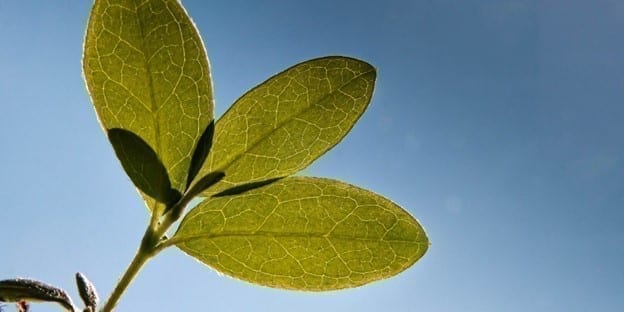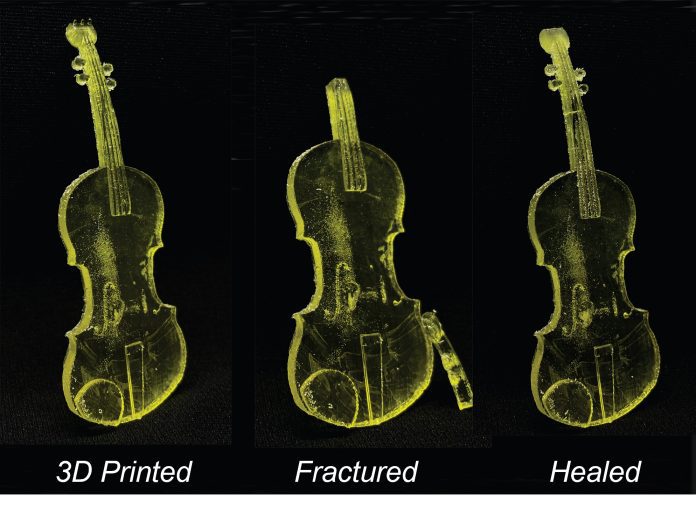
*This is not jello.* This block M is composed of engineered bacteria and silica — a material commonly used in plaster — cross-linking together. The purple tint is a protein produced by the bacteria. If the M was damaged, researchers could add nutrients and any cracks would self-heal.
Credit: Dr. Sunyoung Kang, Postdoctoral Associate, Schmidt-Dannert Lab.
Some engineered living materials can combine the strength of run-of-the-mill building materials with the responsiveness of living systems.
Think self-healing concrete, paint that changes color when a specific chemical is detected or material that could reproduce and fill in a crack when one forms. This would revolutionize construction and maintenance, with wide-reaching economic and environmental implications.
Seeing this new category of adaptive materials on consumer shelves may be a ways off. Still, critical early research from the University of Minnesota sheds new light on this exciting advancement, which shows promise beyond building materials, including biomedical applications.
In a new study in Nature Communications, researchers from the College of Biological Sciences demonstrate how to transform silica — a common material used in plaster and other construction materials — into a self-assembling, dynamic and resilient material.
Currently, the majority of engineered living materials rely on adding a living component into a material. While this additive-approach has benefits, it falls short of the aspirational material — a product that grows, self-organizes, and heals itself. Other researchers were able to engineer a bacteria to produce the target material, but it could only survive in ideal lab conditions. That wouldn’t cut it in real-world applications.
Researchers, led by Claudia Schmidt-Dannert, a Distinguished McKnight Professor in the Department of Biochemistry, Molecular Biology and Biophysics, used a well-studied and benign bacteria, Bacillus subtilis, which goes dormant in unfavorable conditions and springs to life when conditions are favorable for growth. This trait made it a strong candidate as future products would eventually need to be shelf stable and easily activated. The research team then engineered the bacteria and studied the optimal approach to integrate it into the silica structure.
“The first time we saw that the bacteria and the silica were cross-linking and forming a rigid material was pivotal. At that moment, we knew it was working,” says Schmidt-Dannert.
Original Article: Step forward in quest to develop living construction materials and beyond
More from: University of Minnesota
The Latest Updates from Bing News & Google News
Go deeper with Bing News on:
Living construction materials
- How buildings influence the microbiome and human health
Over the last 20 years, the life sciences have come to realize that all living beings—from the simplest animal and plant organisms to humans—live in close association with a multitude of ...
- UNC researchers create artificial cells that act like living cells
The scientific breakthrough could impact regenerative medicine, drug delivery systems and diagnostic tools one day.
- Construction begins on office-to-residential conversion in Utah
Hines has announced the commencement of construction on the redevelopment of South Temple Tower in the US state of Utah. The 217,000ft² building, originally erected in the 1960s, will be redeveloped ...
- Living Future 2024 Conference: Compelling Keynote Speakers, Updated Standards, and a New Book
The International Living Future’s annual conference meets in the Southeast for the first time, celebrating the Living Future community, the newest version of the Just program, and a book about the ...
- Researchers create artificial cells that act like living cells
Researchers describe the steps they took to manipulate DNA and proteins -- essential building blocks of life -- to create cells that look and act like cells from the body. This accomplishment, a first ...
Go deeper with Google Headlines on:
Living construction materials
[google_news title=”” keyword=”living construction materials” num_posts=”5″ blurb_length=”0″ show_thumb=”left”]
Go deeper with Bing News on:
Adaptive materials
- Adidas tailors uniforms for Northwest wheelchair basketball athletes
Adaptive Sports Northwest worked with Adidas designers in Portland to tailor gear for the athletes' performance needs.
- Fizik debuts Antares Adaptive 3D-printed saddle
The evolution of digital 3D printing has allowed Fizik to develop a new saddle without the constraints or limitations imposed by traditional production methods and materials. The Adaptive saddle ...
- Making old buildings new again: the case for adaptive reuse
Extending a structure’s operational life helps maximize the built environment’s embodied energy and sustain the spirit older buildings bring to their communities.
- Promoting residential adaptive reuse in Seattle through policy
Many of the submissions proposed policy changes that would ease the burden of making adaptive reuse a reality ... or greenhouse gas emissions caused by building materials, has not been as widely ...
- The move towards sustainable building practices
Adaptive Homes Ltd., 2023 Revelstoke Chamber of Commerce Business Excellence Award winner in Sustainability, crafts quality builds.
Go deeper with Google Headlines on:
Adaptive materials
[google_news title=”” keyword=”adaptive materials” num_posts=”5″ blurb_length=”0″ show_thumb=”left”]










